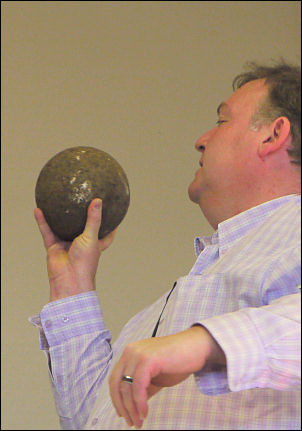|
Charles
Singleton has been the House Manager at Rufford Old Hall for 3 ˝
years. He traced his interest in the Civil War back to having
watched the Sealed Knot at Hoghton Tower in the 1970s.
He explained Lancashire’s population, religion, agriculture and
politics at the outbreak of war in 1642. The causes of war, both
national and local, were explained along with the major players
on both Royalist and Parliamentarian sides.
Lancashire, Charles said, was the first place in the country
that took up arms and was also the last place to lay them down.
It was also the place where some of the major battles and sieges
took place too. This was aided by the use of maps that
illustrated the conflicts and their dates. |

Charles Singleton with the canon
ball he found near York. |
|

Prince Rupert of the Rhine |
The conflict in
Lancashire for the first 2 years was confined to locally based
forces. It was only in 1644 that the conflict widened by the
arrival of Prince Rupert of the Rhine and his forces to retake
the north for the Royalists. He was a consummate professional
who organised the military and economy. Prince Rupert led a
trail of battles through Lancashire, which led him to the Battle
of Marston Moor, near York in July 1644. This led in turn to the
Parliamentarian march into Lancashire, which led to the end of
the Royalist cause there apart from the siege of Lathom Hall of
1644-45.
Charles concluded his talk with his thoughts on why the
Lancashire Royalists failed. Finally, he produced a 17th century
12lb cannon that, he said, was found near York. This, and his
talk in general, generated plenty of questions, which rounded
off an enjoyable evening. |